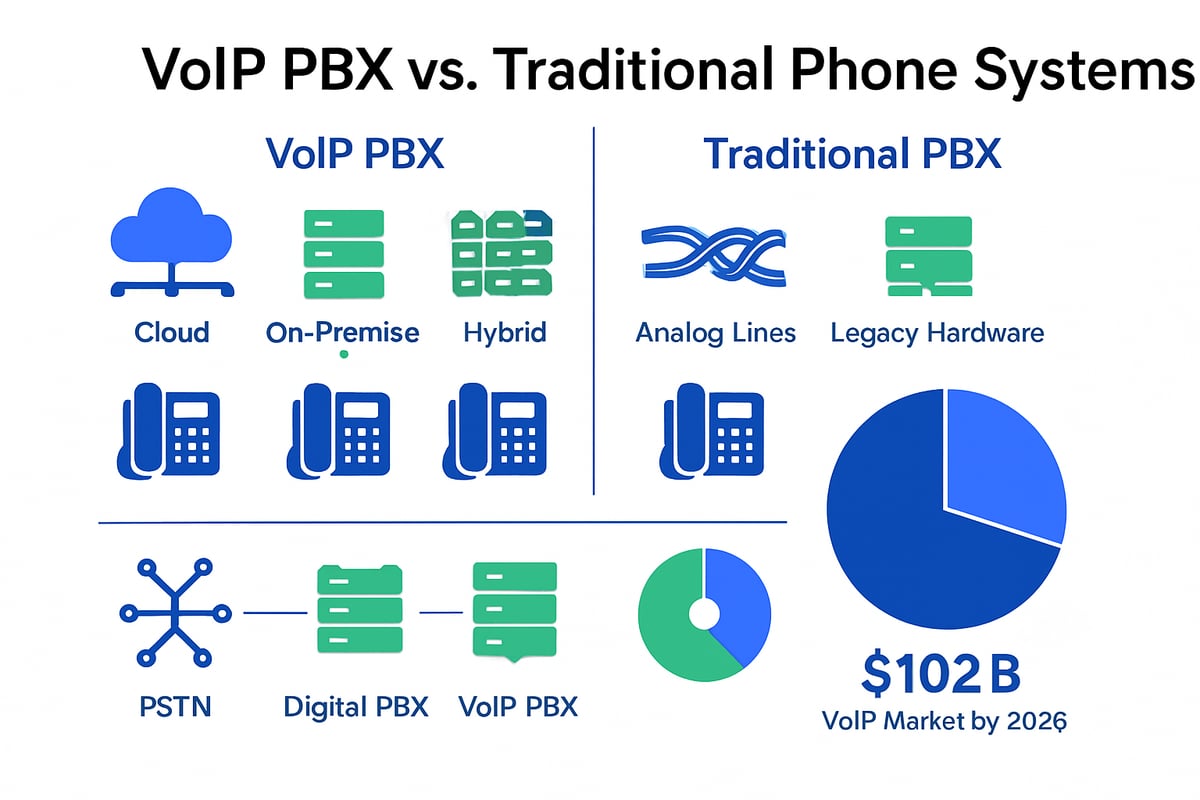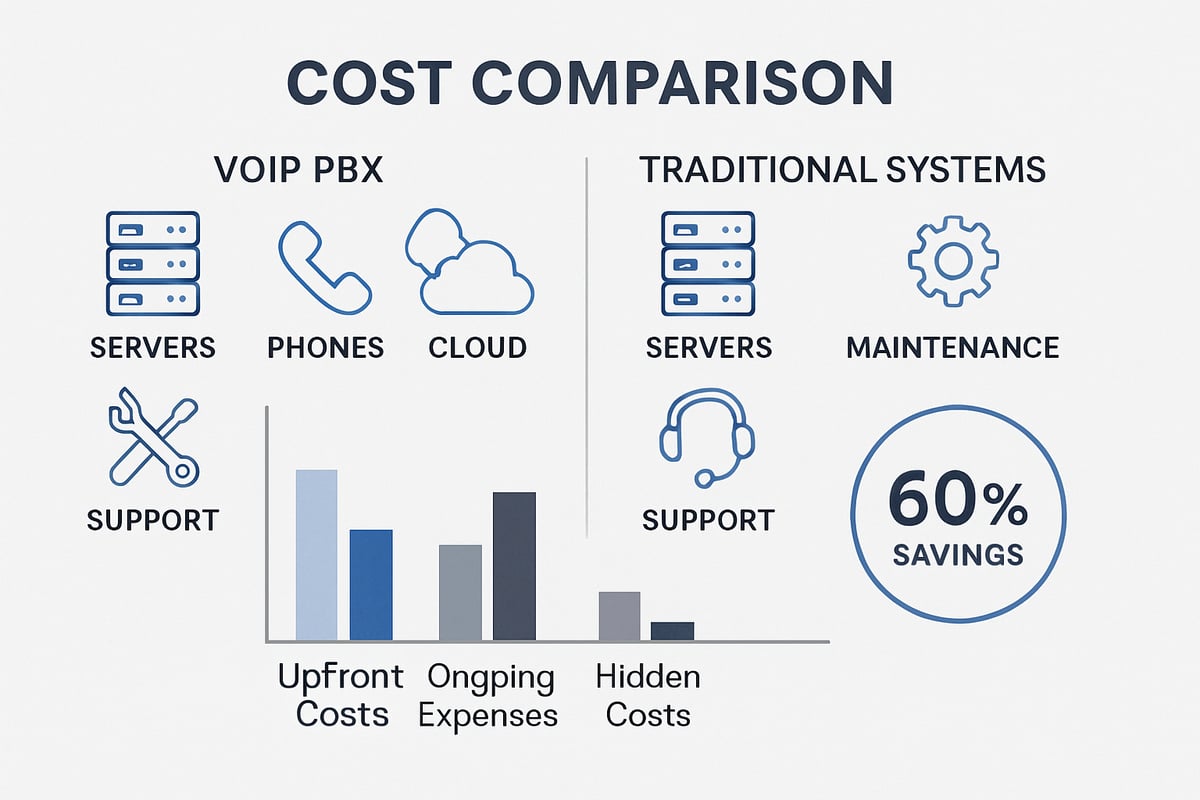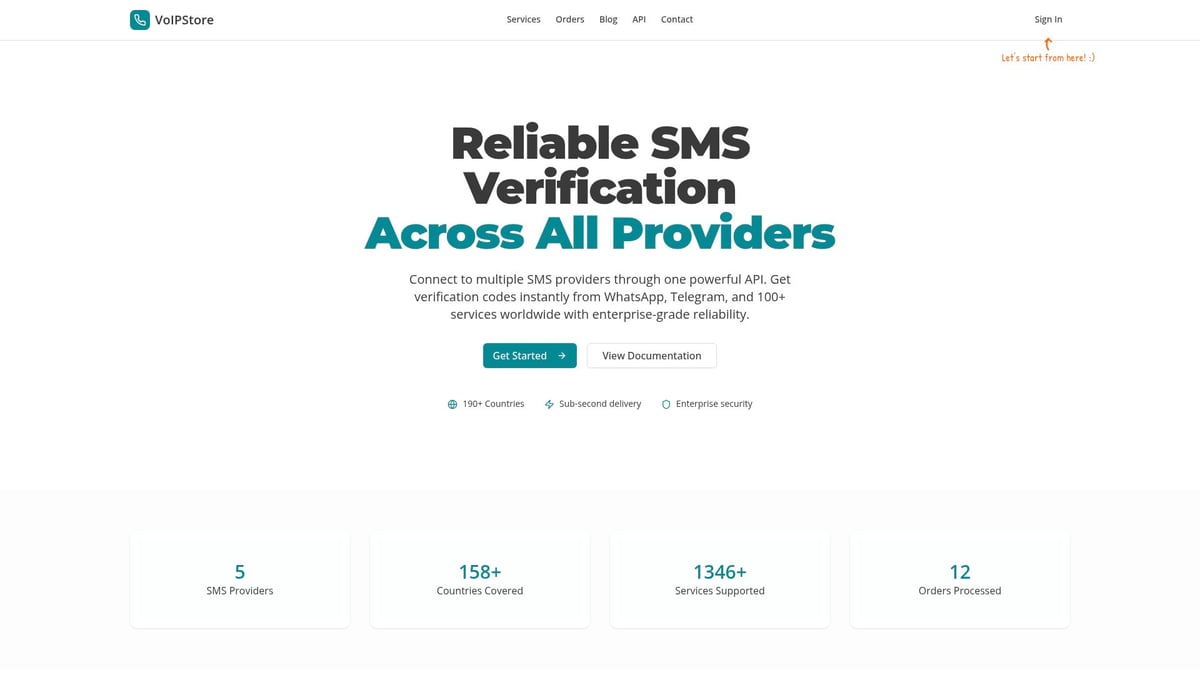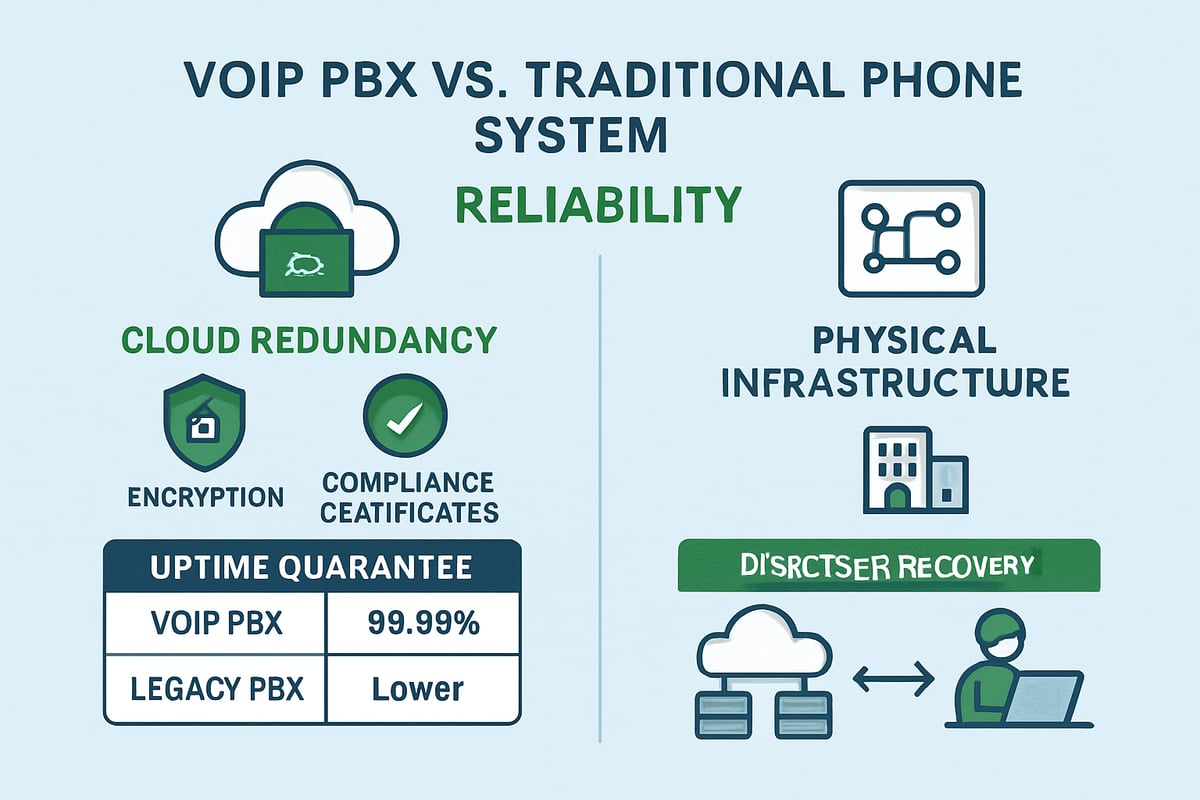Voip PBX Versus Traditional Systems: 2025 Comparison Guide
Compare VoIP PBX and traditional phone systems in 2025 with expert insights on features, costs, security, and scalability to guide your business communication decisions.
Redaction
21/09/2025, 12:30:00In 2025, digital transformation is reshaping the way organizations communicate, creating a crucial decision point for businesses everywhere. Companies now face a clear choice: embrace modern solutions like voip pbx, or stick with traditional phone systems as the technology landscape evolves.
This guide presents a balanced, data-driven comparison of both options. Our aim is to help your organization make a confident, informed decision based on architecture, costs, features, reliability, security, scalability, and emerging trends.
Ready to future-proof your business communications? Explore the strengths and limitations of each system, understand their real-world impact, and take the next step toward the solution that best aligns with your goals.
Understanding VoIP PBX and Traditional Phone Systems
As organizations evaluate their communications strategy for 2025, understanding the fundamental differences between voip pbx and traditional phone systems is essential. Both systems serve the same core purpose - connecting people efficiently - but their underlying technologies, features, and growth potential differ significantly.

Definitions and Core Concepts
A voip pbx (Voice over Internet Protocol Private Branch Exchange) is a modern phone system that transmits voice and data over IP networks instead of through traditional phone lines. Unlike legacy systems, voip pbx leverages digital packet switching, allowing calls to traverse the internet or private data networks with high efficiency.
In contrast, traditional phone systems rely on analog circuit switching, using the Public Switched Telephone Network (PSTN) and copper wiring. These setups include legacy PBX hardware that physically manages call routing within an organization.
Key architectural differences:
| Feature | VoIP PBX | Traditional PBX |
|---|---|---|
| Transmission Method | Digital (IP packets) | Analog (circuit switching) |
| Infrastructure | On-premise, cloud, or hybrid | On-premise hardware |
| Scalability | High (virtual, remote capable) | Limited (physical expansion) |
| Integration | Web/mobile apps, APIs | Physical handsets only |
Voip pbx comes in several models:
- On-premise: Hardware installed at the business site, managed internally.
- Cloud: Hosted by a provider, accessed via the internet.
- Hybrid: Combines local and cloud infrastructure.
The transition from PSTN to digital PBX, and now to voip pbx, reflects decades of innovation. Modern solutions like 3CX highlight how hosted IP PBX offers greater flexibility and easier management than on-premise PBX.
A clear example can be seen in the way on-premise systems require dedicated servers and maintenance, while cloud voip pbx reduces hardware needs and offers rapid deployment. According to industry reports, the global VoIP market is projected to reach $102 billion by 2026, underlining the rapid shift toward these next-generation platforms.
How Each System Works in Practice
The operational differences between voip pbx and traditional phone systems become apparent in daily business activities. Voip pbx uses SIP trunking to route calls over the internet, while traditional systems depend on copper lines for connectivity. This distinction impacts both flexibility and geographic reach.
Hardware requirements differ:
- Voip pbx: IP desk phones, network switches, servers (for on-premise), or cloud access.
- Traditional: Analog phones, proprietary PBX hardware, copper wiring.
Voip pbx supports integration with mobile and web applications, enabling remote work and unified communications. Traditional systems, in contrast, are tied to physical handsets and office locations, limiting mobility.
For example, 3CX recommends corporate network segmentation to maintain call quality in voip pbx deployments. This ensures business-critical voice traffic receives priority.
Consider the process of adding new users. With voip pbx, administrators can provision extensions or lines through a web portal in minutes, whether on-site or remotely. Traditional systems often require physical installation, rewiring, and manual configuration, which is both time-consuming and costly.
For a comprehensive comparison of how these systems differ in features, architecture, and deployment, see PBX vs VoIP: How to Compare and Choose a Phone System.
Ultimately, voip pbx delivers a modern, flexible approach to business communication, while traditional systems remain bound by legacy constraints.
Cost Analysis: VoIP PBX vs. Traditional Systems
In today's business landscape, cost efficiency remains a critical driver when evaluating phone systems. As organizations consider upgrading to a voip pbx or retaining traditional telephony, understanding the total cost of ownership is essential. Let’s break down the real expenses, both visible and hidden, to help you make a data-driven decision.

Upfront and Ongoing Expenses
The initial investment is often the first hurdle for businesses choosing between a voip pbx and a traditional phone system. Traditional systems typically require a substantial upfront outlay for proprietary hardware, physical wiring, and professional installation. These legacy systems also depend on desk phones, PBX cabinets, and ongoing maintenance contracts.
By contrast, a voip pbx leverages digital infrastructure and often offers cloud-based deployment. This significantly reduces hardware needs, as businesses can use existing computers, softphones, or mobile devices. Installation is streamlined, and many solutions, such as 3CX, emphasize that voip pbx platforms are “much easier to install & configure” than legacy alternatives. Cloud options further minimize capital expenditure, replacing large upfront costs with predictable monthly fees.
Ongoing expenses also differ sharply. Traditional systems require periodic hardware upgrades, dedicated IT staff for maintenance, and support contracts that can add up over time. Voip pbx solutions offer scalable licensing, enabling businesses to pay only for active users or extensions. Upgrades are often automatic, especially with cloud-based models, reducing the administrative burden.
Cost Comparison Table
| Expense Type | VoIP PBX | Traditional System |
|---|---|---|
| Hardware | Minimal, scalable | High, proprietary |
| Installation | Simple, remote possible | Complex, on-site required |
| Maintenance | Low, cloud-managed | High, manual |
| Upgrades | Included, automatic | Costly, periodic |
| Support | Included or on-demand | Contract-based |
A compelling statistic for decision-makers: Businesses can save up to 60% on phone bills by switching to a voip pbx, according to industry averages. These savings stem from reduced infrastructure, lower maintenance, and more flexible pricing models.
Hidden and Variable Costs
While upfront and recurring costs are crucial, hidden expenses can dramatically affect the total cost of ownership. For example, international calling and long-distance rates are often much lower with a voip pbx, thanks to internet-based routing and competitive global carrier partnerships.
Adding or removing users is another area where voip pbx systems shine. Traditional setups require physical rewiring or new hardware for each extension, leading to increased labor and equipment costs. In contrast, voip pbx platforms allow instant provisioning or deactivation of users with minimal effort and no new hardware.
Downtime and disaster recovery also play a significant role. Traditional systems are vulnerable to outages due to reliance on physical infrastructure, resulting in costly disruptions. Voip pbx solutions can utilize geographic redundancy and rapid rerouting, minimizing business interruptions and associated losses.
Remote work has further highlighted these differences. In a recent case study, organizations that migrated to voip pbx platforms enabled seamless remote connectivity for employees, reducing both travel and office space costs. Traditional systems, by comparison, struggled with the flexibility required for distributed teams.
For organizations seeking advanced cost optimization, solutions like VoIP and PBX service offerings provide global SMS, voice routing, and integration capabilities. These features help businesses control expenses while expanding their communication reach, making voip pbx an attractive option for cost-conscious enterprises.
In summary, evaluating both the direct and indirect costs reveals that voip pbx systems provide greater financial agility, scalability, and long-term savings compared to traditional phone systems.
Features and Functionality Comparison
As organizations evaluate communication solutions, understanding the features and functionality of each platform is crucial. Both traditional systems and modern voip pbx solutions offer distinct capabilities, but their differences shape business efficiency, flexibility, and growth potential.
Core Communication Features
Call quality and reliability remain foundational to any business phone system. Traditional systems rely on analog lines, ensuring stable audio but often lacking advanced call management. Voip pbx, on the other hand, utilizes digital packet switching and can deliver high-definition voice, provided the network is optimized.
Below is a comparative summary:
| Feature | Traditional Systems | VoIP PBX Solutions |
|---|---|---|
| Call Quality | Analog clarity | HD voice, QoS |
| Call Routing | Manual, limited | Advanced, automated (IVR) |
| Voicemail | Basic, on-premise | Cloud-based, accessible remotely |
| Call Recording | Add-on, limited | Built-in, scalable |
| Scalability | Hardware-bound | Instantly add lines/extensions |
| Remote Access | Rare, complex | Native, mobile/web apps |
Voip pbx systems excel in call routing, auto-attendant, and interactive voice response (IVR) capabilities. Adding new users is seamless, often requiring just a few clicks. For example, 3CX integrates video conferencing, live chat, and contact center features, while traditional systems typically restrict users to voice calls and physical handsets.
A recent industry statistic highlights that businesses can save up to 60% on phone bills by leveraging voip pbx, mainly due to reduced hardware and maintenance requirements.
Advanced and Integrated Tools
Modern business demands go beyond voice. Voip pbx platforms support unified communications, offering video meetings, team chat, SMS, and collaborative workspaces within a single interface. Integration with productivity tools, such as Microsoft 365 or Google Workspace, is standard. This enables seamless workflows and boosts productivity.
Remote work readiness is another key advantage. Voip pbx solutions allow employees to connect from anywhere using mobile or web apps, supporting BYOD and hybrid work models. Traditional systems, in contrast, are office-bound and lack integration flexibility.
Voip pbx also stands out with advanced features like AI-powered analytics, automated call routing, and real-time reporting. Over 70% of businesses now cite flexibility as the main reason for adopting voip pbx, according to industry data. For a deeper dive into technical feature comparisons and security considerations, see VoIP vs PBX: Choosing the Right Phone System in 2024.
The limitations of legacy systems are clear: they struggle to integrate with CRMs or third-party apps and often lock businesses into proprietary hardware. Voip pbx, by contrast, remains future-ready and adaptable.
VoIPStore: Global VoIP and SMS Solutions for Modern Businesses
VoIPStore empowers organizations with enterprise-grade voip pbx and SMS services, connecting to carriers worldwide for maximum reliability. Its platform offers a robust SMS verification API, global virtual numbers in more than 190 countries, and real-time analytics for data-driven communication.

Key features include:
- Fast, developer-friendly API for easy integration.
- Intelligent routing for sub-second message delivery.
- Cost optimization tools to manage global communication expenses.
- Dedicated support for enterprises and developers.
- Seamless integration with over 100 platforms, including WhatsApp and Telegram.
VoIPStore’s developer-centric approach ensures that voip pbx deployments remain scalable, secure, and efficient for global operations. Whether your team is distributed or centralized, VoIPStore delivers the flexibility and reliability needed for modern business communications.
Reliability, Security, and Compliance
Navigating the reliability, security, and compliance requirements of business communications is critical. As organizations transition to modern solutions, understanding how voip pbx compares to traditional phone systems in these areas is essential for risk management and operational resilience.

System Reliability and Uptime
Reliability is a pillar of any business phone system. voip pbx solutions are engineered for high availability. Most providers offer cloud hosting with built-in redundancy, automatic failover, and geographically distributed backups. This design helps maintain service even during local outages.
Traditional systems, in contrast, depend on physical PBX hardware and copper lines. Service interruptions can result from equipment failure, power loss, or infrastructure damage. Restoring service may involve manual repairs and longer downtimes.
Here’s a quick comparison:
| Feature | VoIP PBX | Traditional Systems |
|---|---|---|
| Uptime SLA | 99.99% (cloud providers) | 95-99% (varies) |
| Redundancy | Cloud/geographic | Local hardware only |
| Failover | Automatic, instant | Manual, time-consuming |
| Disaster Recovery | Built-in, remote access | Complex, office-based |
For organizations needing always-on communication, voip pbx offers a clear reliability advantage.
Security Considerations
Security remains a top concern for any communication platform. voip pbx systems employ a range of advanced technologies to safeguard data and calls:
- End-to-end encryption for voice and signaling
- Firewalls and Network Address Translation (NAT) traversal
- DDoS attack protection
- Multi-factor authentication for admin access
- Regular security patches and monitoring
Traditional phone systems are less exposed to cyber threats but remain vulnerable to wiretapping or unauthorized physical access. However, they lack the advanced security controls and analytics that voip pbx providers offer.
Compliance is another factor. voip pbx solutions frequently support GDPR, HIPAA, and local telecom regulations, giving businesses tools for audits and reporting. Providers regularly update their platforms to address new threats. For ongoing best practices in this rapidly evolving landscape, industry sources such as the VoIP industry updates and insights offer valuable guidance.
Business Continuity and Disaster Recovery
A robust disaster recovery plan is vital for minimizing downtime. voip pbx excels here with features like geographic redundancy, automatic rerouting, and seamless remote access. In the event of a disruption - whether a natural disaster or office closure - calls can be redirected instantly to mobile devices or remote locations.
Traditional setups often have a single point of failure. If the PBX hardware or local lines are compromised, restoring service may require on-site intervention. Scaling or enabling remote work is also challenging, as these systems are tied to physical office infrastructure.
voip pbx enables organizations to maintain operations during unforeseen events. Rapid failover and flexible routing help businesses stay connected with clients and teams, supporting modern hybrid and remote work environments.
Scalability, Flexibility, and Global Reach
Adapting to rapid business change in 2025 requires communication systems that scale easily, support flexible work, and enable global operations. The right solution ensures growth is seamless, teams stay connected, and technology investments remain future-proof. Let’s explore how voip pbx and traditional phone systems measure up across these critical areas.
Scaling Users and Locations
Scaling communication as your business grows is straightforward with voip pbx. Adding users, extensions, or new office locations can be completed in minutes, thanks to cloud provisioning and intuitive management portals. Businesses can expand globally, leverage virtual numbers, and port numbers across 190+ countries, supporting international teams and customers.
Traditional systems, in contrast, require physical wiring, new hardware, and manual installation for every new user or location. This approach is costly and time-consuming, often leading to disruption during expansion. The following table summarizes the differences:
| Feature | VoIP PBX | Traditional Phone System |
|---|---|---|
| User Provisioning | Instant, cloud-based | Manual, on-site |
| Global Expansion | Seamless, virtual | Hardware-dependent |
| Number Portability | Supported globally | Limited, local only |
For organizations ready to scale, it’s possible to Place VoIP PBX orders online and begin deploying services immediately, minimizing downtime and upfront costs. With voip pbx, scaling is no longer a bottleneck but a competitive advantage.
Flexibility and Remote Work
The modern workforce is increasingly mobile, and voip pbx meets these demands with robust support for remote and hybrid work environments. Employees can use mobile apps, softphones, or web clients to stay connected from anywhere, whether at home, in the office, or on the go.
Traditional systems are tied to physical locations and desk phones, limiting flexibility and making remote work challenging. By embracing voip pbx, organizations eliminate the need for desk phones and unlock new levels of agility. For a deeper look at this transition, see Ditch Desk Phones In 2025: The Modern Business Communication Shift.
A real-world example: During the pandemic, companies using voip pbx rapidly enabled remote work, while those on legacy systems struggled to adapt. Flexibility is now a must-have, and voip pbx delivers it.
Integration and Future-Proofing
Staying ahead in a digital-first world means choosing solutions that integrate with other business tools and support ongoing innovation. Voip pbx platforms offer API access, seamless integration with CRM, messaging, and collaboration apps, and benefit from regular feature updates.
Traditional systems lag in this area, often locking businesses into proprietary hardware and limited upgrade paths. As a result, companies find it difficult to add new features or adapt to changing needs.
According to industry reports, 85% of new business phone deployments in 2024 were voip pbx-based, underscoring the shift toward future-ready communications. Investing in voip pbx is a strategic move for long-term growth and resilience.
Future Trends and Decision Factors for 2025
As the business communications landscape evolves, organizations face critical decisions about their telephony infrastructure. Looking ahead to 2025, several trends and criteria will shape how companies select between voip pbx and traditional systems.
Market and Technology Trends
The global shift from legacy telephone infrastructure is accelerating as multiple countries phase out PSTN networks. This transition is compelling businesses to re-evaluate their options. In 2025, voip pbx solutions are leading the way by integrating artificial intelligence, automation, and advanced analytics.
Providers such as 3CX and Nextiva are incorporating AI-driven features like intelligent call routing and real-time sentiment analysis. There is also a marked rise in omnichannel communications, allowing businesses to connect with customers via voice, SMS, chat, and video from a single platform.
These innovations make voip pbx systems increasingly attractive for companies aiming to future-proof their communications while maintaining flexibility and scalability.
Key Decision Criteria for Businesses
Selecting the right telephony system requires a careful assessment of organizational needs. Business size, growth projections, and budget constraints all play a role. Regulatory requirements, such as GDPR or HIPAA, can also influence the decision.
Reliability and flexibility are top priorities for most companies, especially as hybrid work models become the norm. Migration strategies, whether phased, hybrid, or full transitions, should be evaluated with guidance from experts like 3CX.
Consider these key questions when choosing between voip pbx and traditional systems:
- What is the expected growth in users or locations?
- Are remote work capabilities essential?
- What integrations with business tools are required?
- How important is compliance and data security?
- What is the total cost of ownership over five years?
Real-World Use Cases and Industry Adoption
Adoption of voip pbx varies by industry and business size. Small businesses often seek cost savings and flexibility, while enterprises demand robust integrations and global reach. For industries like healthcare, finance, and retail, compliance and security are paramount.
For example, many organizations have realized significant benefits by migrating to voip pbx, especially during the shift to remote work. Over 65% of enterprises plan to upgrade to voip pbx by 2025, driven by these advantages. Small businesses, in particular, can gain a competitive edge and reduce expenses, as detailed in the VoIP vs. Traditional Phone Systems: Cost Savings for Small Businesses in 2025 report.
Whether adding new locations or enabling hybrid work, voip pbx empowers organizations to meet modern demands and stay agile in a rapidly changing environment.Now that you have a clear picture of how VoIP PBX systems stack up against traditional phone setups for 2025, you can see the advantages of modern, scalable communication for your business. If you are ready to experience reliable connections, real-time analytics, and seamless integration with services like WhatsApp and Telegram, VoIPStore has you covered with enterprise-grade performance in over 190 countries. Taking the next step is easy. Whether you are a developer or an enterprise leader, now is the perfect time to explore flexible, future-proof solutions - Start now!